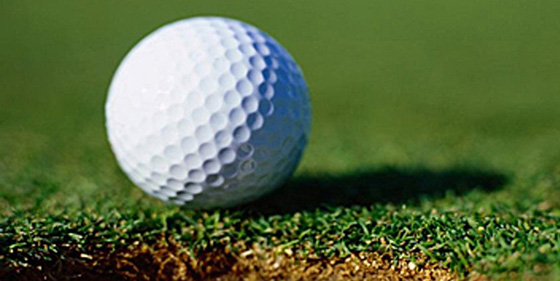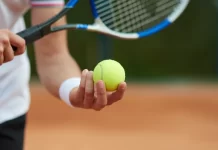Golf Ball Core
The source of energy in a golf ball is its core. Its construction type is what affects the spin rate (control), velocity (distance), and compression (feel). The core of a golf ball is either a wound core or a solid core.
A wound core is a small solid or liquid filled rubber sphere that is wound with rubber thread. A sold wound center is simply a small, solid rubber ball. The liquid wound center is a small, hollow rubber ball that is filled with either a liquid or a paste. With both types, either the centers are wound to a predetermined size to optimize velocity and spin and then a balata or durable cover is applied. The amount of thread used per golf ball will vary. Usually, about 35 yards of thread will be stretched to about 275 yards as it is wound. A wound core construction is also referred to as a three-piece ball
A solid core in a two-piece ball is composed of a single piece of solid, elastic material. The solid core is typically made of a high resiliency rubber compound with a blend of additives to further enhance its performance. A cover is then applied.
Dimples Drive Drag Out of Golf Balls
Tiger Woods knows about drag during a drive. Once off the tee, a golf ball immediately starts to slow down. It’s aerodynamic. We deal with it by making golf balls that have dimples.
Please consider the following: Well hit golf balls go about 200 kilometers per hour (120 miles per hour). That’s fast. And, at that airspeed, sticky air slows a ball down a lot. That’s right, air is sticking to the ball, and that can create a bumpy ride. Think about this: when a ball falls in a water hazard, it gets wet, right? So, when a ball is streaming through the air, it gets wet with air. We say it has a “wetted surface.”
Because air is sticking to the surface it streams over, it makes sense that the less area you have on a ball, the less sticking you’d get and the less drag you’d have to overcome. So, you might think that a very smooth, air-hardly-sticks-to-it-at-all coating on a polished sphere would travel farther down range than a ball with a roughed up lemon or lime skin surface. But, at the airspeeds that golf balls go, it doesn’t quite work that way.
Imagine yourself as a tiny entity, smaller than a gnat, perhaps the size of a micro crustacean — so small you could fit between grains of sand on a beach. Now imagine riding on the surface of a golf ball in flight, or in the wind tunnel at the lab. You realize that right at the surface of the ball, the air is still and it sticks to the plastic as the air molecules are dragged along like syrup running from the rim on a little pitcher at a popular pancake breakfast place.
But as you swim up away from the surface, say as far as the thickness of three sheets of paper, you notice that the air is going full speed. You’re in, what we in golf science call, the “free stream” which moves at 200 kph. (You may have to ride a few flights to collect all the data we’re covering here. That’s of course after you get that micro entity thing worked out.) Anyway, the air streaming over a golf ball forms a “boundary layer” of relatively slow moving air. It’s distinct. Right at the surface, the air is stuck. A millimeter away from the surface, the air is going full blast. In between — in the boundary layer — it’s just slurping along.
So here’s the deal. That slow moving air in the boundary layer is a drag. Uh, I mean, it’s a source of drag. It lets the air stick to the surface and tumble behind the ball in wild whipping whirlpools.
The energy in the boundary layer is lost energy. The tumbling air behind the ball allows a large (relatively large, it’s just a golf ball) region of low pressure to form, creating a partial vacuum that would suck the ball back toward the tee. So, the thinner we can make the boundary layer, the less slurpy drag we’ll have, and the sooner the air behind the ball can get back up to the “free stream” speed (at least from your micro entity point of view). The less drag, the farther the ball will be driven.
Here’s where the dimples do their job. Dimples make the molecules in the layer tumble. They start roiling against one another. We say the boundary layer becomes “turbulent.” The molecules in the layer are no longer just sliding across the surface gently jostling. Now, they’re rolling and bouncing and bumping each other along. When the molecules are in a turbulent boundary layer, they’re moving closer to the free-stream speed. There is less of a difference between the speed of the tumbling molecules and the speed of the ball.
It turns out that the air flow in a turbulent boundary layer on a dimpled golf ball is thinner than a smooth or “laminar” flow on, say, a ping-pong ball. Boundary layers are laminar or turbulent, or somewhere in between. We say they’re in “transition.” Dimples make the transition quick– not a smooth transition, a turbulent one, ha! (A little fluid dynamics gag there…) When the layer is turbulent and thin, the ball loses less energy to the free stream air. And, drag is lower. Isn’t that weird? The dimples make the ball develop less drag. Weird, huh?
By the way, boundary-layer control is a big deal for birds and airplanes, too. Bird feathers have all manner of turbulent tumbler tines. And, airplanes have splitter plates, strakes, chines, vanes and turbulators to make the boundary layer do what we want it to. By the time the boundary layer reaches the aft end of a 777, it can be a meter thick. It’s sticky stream that we have to manag
When it comes to drag on a drive, dimples smooth things out. Golf is a game, but down deep in the dimples, it’s science!
By Bill Nye “The Science Guy”
Follow the Bouncing Octahelix Dimple Pattern
Balls are on the front lines of the economic and ethical equipment battles. Some golfers fear that advances in equipment may render some of the game’s most storied courses obsolete (although you won’t hear them complain about extra yards off the tee). All we can say is it hasn’t happened yet. After all, whether the ball is stuffed with feathers or liquid or rubber, golf remains a game of accuracy and consistency, not merely distance. Because balls fly farther doesn’t mean they necessarily fly straighter.
Which ball you favor, like clubs, shafts, grips or head covers, is a matter of personal preference. Golf has always been a fount of eccentricity and superstition. Some golfers won’t play high numbered balls because they think they encourage higher scores. Others prefer balls with the number 8 on them, in the belief that they offer better symmetry in flight. Who knows?
Shopping for golf balls can be confusing. On the outside of the box (commonly called a ‘sleeve’), you’ll often find various product descriptions. Like most products, golf balls are tailored to fit the needs of different clienteles. Three terms every golfer should have at least a working knowledge of are: compression, balata and surlyn.
Compression is an industry yardstick that measures the hardness of the ball. The higher the compression the harder the ball. Three-piece balls have liquid centers wound with elastic and covered with balata rubber. They’re said to be easier to put backspin on and curve more easily in flight, attributes that make them more appealing to professionals. Balata balls are, however, more susceptible to cuts and scuff marks.
Two-piece balls have a solid synthetic center covered with surlyn. They are believed to be the more durable of the two and roll farther, but are harder to put English on. Because of their durability (not to mention the possibility of a few extra yards), two-piece surlyn balls at 90 compression are recommended.
We can make one unqualified endorsement. X-out balls, on most store and pro shop shelves, sell for considerably less than top-of-the-line models. Some golfers won’t touch them, but for the average player they play as true as a regular ball in both velocity and distance. X-outs are factory overruns or balls with cosmetic blemishes. They’re also brand-new (as opposed to the jar of used and possibly water-logged balls on pro shop counters). The ones with corporate logos or business names on them are the best of the bunch.
Water, Water, Everywhere
The following is a recent reprint from GOLF DIGEST on the pros and cons of the reprocessed golf ball. Or, more precisely, the reprocessed water ball.
Here, my friends, is the $64,000 question. Exactly how much life is left in those golf balls that have been fished out of the water? The cover of a golf ball seems fairly impervious, so how bad could it be for a ball to sit idly in the water for a few months? Does a ball that’s been lying lying in the mud at the bottom of a pond for 30 days lose distance? Does it gain distance? Does being submerged for a length of time have any effect whatsoever?
Like most golfers, GOLF DIGEST editors recover their fair share of water balls (that’s right, we’re as cheap as the next guy), and also like most golfers, we wanted to know what we were getting from these somewhat soggy transactions. We’re not the only ones interested in recycled balls, either.
Here’s how we went about investigating the playability of balls pulled from the water, and keep in mind that the test was not all-inclusive. We used only three-piece, balata-covered balls and two-piece balls with a lithium-Surlyn cover.
Step 1: We took 11 new three-piece balls and 11 new two-piece balls and submerged them in a pond for eight days. We took another 22 new two- and three-piece balls and submerged them for three months. Then we took a third batch of 22 new balls and let them sit in the water for six months. The average water temperatures ranged from 36 to 70 degrees Fahrenheit during this period.
Step 2:We recovered the balls last November and tested them using a robotic hitting machine. The golf club used was a standard-length metal driver (9.5-degree loft) with an extra-stiff shaft. Clubhead speed was 93.7 m.p.h., launch angle was 9 degrees and the average spin rate was 2,800 r.p.m. On the day of the testing, the wind was calm and the fairway was a bit damp.
Step 3:We started testing by hitting 11 new two- and three-piece balls as a benchmark (same brands and models as the water balls). The average carry and roll for the new three-piece balls was 250.7 yards. These numbers are not the maximum carry and roll for two- and three-piece balls, simply the average carry and roll under our test conditions.
The next stage was to hit the ballsthat had been retrieved from the water. The average carry and roll for three-piece balls that had been in the water for eight days was 235.7 yards. That distance shrunk to 229.4 yards after three months and to 226.2 yards after six months.The differences? A six yard loss of distance after eight days, a 12-yard loss after three months and a 15-yard loss after six months.
For the two-piece ball,the carry and roll after eight days in the water was 244.9 yards compared with 250.7 yards for the new two-piece balls. The average carry and roll for two-piece balls after three months in the drink was 241.6 yards. The two-piece balls that spent six months under water averaged 242.5 yards.The bottom line is that the two-piece ball came up almost six yards shorter after being submerged for eight days. It lost another 3.3 yards (9.1 total) after three months, yet interestingly enough, after six months in the water, the two-piece ball averaged one yard farther than the ball that had been in the water for three months.
“Golf balls basically have a non-porous cover,” says Mike Sullivan, senior director of research and development worldwide for Spalding, maker of Top-Flite golf balls, “but like with any plastic or polymer, they are subject to chemicals passing through them. We have looked at this in great detail, because we certainly don’t want the balls to be affected one way or the other by humidity or wet fairways.
“For a two-piece ball, being in the water typically makes the ball harder in terms of compression, and it also slows down the coefficient of restitution (the ability of the ball to regain its roundness after impact), and that makes it fly shorter. Three-piece balls are the opposite in that they get softer in terms of compression, but they will also fly shorter. We have no data that says water hurts three-piece balls more than two-piece balls, but soft-cover balls are obviously a bit more permeable than hard-cover balls.”
Another opinion comes from Ron Vanasdale, a senior executive vice president for the golf ball division of Sport Supply Group, a publicly held company that claims to operate the largest golf ball recycling business in the nation. “I can honestly say that we have done tests in the tens of thousands utilizing our environments, and I’ll tell you this much, your numbers are off. It’s all relative to the types of balls, the makes of balls, when the balls were made and the types of composition of the cover stock,” says Vanasdale.
We also asked Howard Stone, a professor of chemical engineering and applied mechanics at Harvard University, for his opinion on what effect water could have on golf balls. Given how long they were in the water, there are two things that might have happened,” says Stone. “You might have absorbed a little bit of water into the ball so the ball might not only be a bit heavier, but it might have a slightly larger radius, and both of those factors, in general, will tend to affect the aerodynamic performance, making the ball fall faster. Water may also affect the structure of the molecules in the ball and might cause it to swell a little, a common effect in polymers (the scientific name for various materials used to make golf balls, such as Surlyn, balata, elastomer, etc.).”
The missing link in this equation is that when you scoop a ball from the water, you never know how long that ball has been sitting there. So, the next time you see a little white orb shimmering in the shallows of a nearby pond, remember the adage, all that glitters is not gold.
© Peter Farricker and Golf Digest Magazine, January 1996
Everything you need to know about golf balls
Question:Some questions regarding the life of golf balls.
How long can you store golf balls before they lose their elasticity?
How long can you play the same ball before it starts causing you to lose distance?
What is the best way to store golf balls over the winter?
Any other words of wisdom concerning golf balls?
One other question. What are your thoughts concerning leaving graphite shafted clubs in the trunk of your vehicle overnight? Also, do you store them upright or laying down? — M.K., Bolivar, Ohio
Answer:Let’s take your questions one at a time.
According to my friends at the Acushnet Company, the shelf life of a golf ball is three to five years.
How long you can play the same ball before you start losing distance depends on who’s hitting it. A good player could use the same ball for many rounds without noticing a loss of distance, but probably wouldn’t, because cosmetically, the ball would lose its shine. A poor player, who swings the club at the ball like a logger swinging an ax, will probably lose distance quickly because the ball will be knocked out of round and won’t have a true ball flight.
Store golf balls at room temperature.
Stick to the brand names for the best quality and consistency.
Finally, storing your clubs in your trunk overnight isn’t a good idea because of the heat and humidity the builds up in there. Also, it takes a thief about ten seconds to remove them, leaving you with an empty trunk. Laying them down or standing them up would make no difference. I’m curious. What kind of car has a trunk deep enough to stand a set of golf clubs in it?
by :Jon Ebert, a golf consultant and teaching professional
How to Take Great Golf Photographs
“Be the ball!”
Ah, that sage advice offered by Chevy Chase in one of our all time favorite movies, Caddyshack, should be kept in mind by photographers who hoist a camera on the links.
In a nutshell, sports photography is tough. While there are lots of great sports photos published, the average newspaper is full of mediocre sports photos nearly every day. It’s hard to get a good photograph of action in most sports.
That’s the bad news. The worse news is that golf is one of the hardest sports to photograph. There’s no physical contact between players, the course is tremendous and the ball is tiny and travels very rapidly through the air. It’s hard to get a good angle without impairing the golfer’s concentration or risking getting conked by an errant drive.
Good golf photography is hard. As NYI students have learned, we say “If it’s hard, that’s terrific!” Because if it’s hard, most people won’t do it, and therefore the benefits and rewards will flow to those that do. With those words of encouragement, let’s turn to the job at hand.
The photographs you can take on the golf course can be broken into several distinct types:
The basic action photos are “big swing” pictures of golfers driving off the tee or hitting long shots in the fairway; players blasting out of sand traps and other hazards; and finally, putting on the green.
In addition there are lots of opportunities to photograph players reacting to their own shot or someone else’s. Finally, we can take “location” portraits of golfers and record some of the scenery on the course.
Before we look at each type of golf photo, it is essential that you remember that regardless of the kind of picture you want to shoot, following NYI’s Three Guidelines for Better Photographs will determine whether or not your photo succeeds.
NYI’s Three Guidelines are best recounted in the form of these simple questions you should ask yourself before pressing the shutter on your camera:
| Guideline One: What is the subject of my photograph?
Guideline Two: How can I give emphasis to my subject? Guideline Three: Is there anything I can do to simplify my photograph? |
Particularly with a subject such as golf, the action of your photo is likely to be so minimal that if there are distractions they will seriously interfere with your photo. Look at the example to the right.
What’s the subject here? The golfer in red? His cart? The town behind? The mountains? We could go on endlessly about the flaws in this photo, but we don’t like to teach from negative examples. Suffice it to say everything here that isn’t the subject of the photograph detracts from whatever is the intended subject. We assume it’s the poorly cropped golfer in the lower left, but the other elements in the picture are certainly putting up a battle to distract the viewer.
If you are unfamiliar with NYI’s Three Guidelines we strongly suggest you look at this month’s Picture of the Month feature. Each month we take an interesting photograph and give it a thorough analysis using NYI’s Three Guidelines. Now let’s look at some good examples of the various types of golf photos.
The Workout
Golf is a fairly complex game, but here’s the gist of it: The goal in golf is to try to get from point A (the tee) to point B (the hole on the green) in as few shots as possible.
Upside
Golf is a game of strategy, so the best athlete doesn’t always win. Anyone from tykes to seniors can play. Walking while pulling a golf cart or carrying your golf bag can help burn calories and up your stamina.
Downside
Break out your credit card — this is an expensive pastime. A round of golf (18 holes) can cost anywhere from $20-$225, not including cart rental. A brand new set of clubs can cost up to $500 for one club, totaling several thousand dollars for a brand new set. Playing can also eat into family time on the weekends.
The Pros Say
-
You don’t need to pay the expensive green fees every time you want to ‘practice.’ Many driving ranges offer a bag of balls for $2-$10 for about 50 balls.
-
This cost of a lesson from a golf pro runs about $30-$150 per hour.
-
Buying used equipment can save you a ton of money and serve your needs, so long as it’s in good condition.
-
Working out to increase strength, flexibility, stamina and balance can help improve your golf game.






